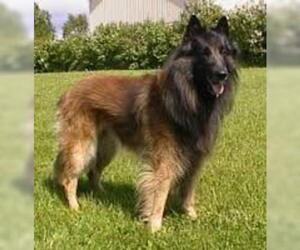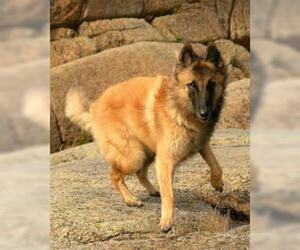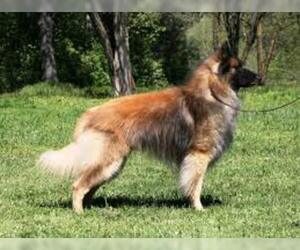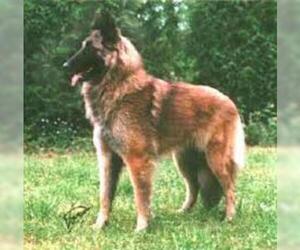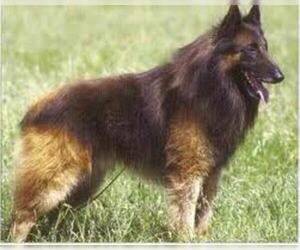
All about Belgian Tervuren dog breed
A.K.A. :Terv, Tervuren Shepherd, Belgian Shepherd Tervuren, BSD-Tervuren, Belgian Terv, Tervie, Belgian Tracker, Fawn Belgian, Belgian Guard Dog, Tervuren Dog, Euro Terv, Terv Patrol, Belgian Working Terv, M-Dog Terv, Tervinator
Size
Grooming requirements
Exercise requirements
Good with other dogs
Watchdog ability
Energetic
Training requirements
Playful
Affectionate
Good with other pets
Good with children
Good with strangers
Winter
Summer
Healthiness
Protective
Life Span
| Pure Breeds | Member |
| Breeds A - Z | B |
| Breeds by Group | Herding |
| Breeds by Trait | Fast Dog Breeds Good With Kids High Stamina Dog Breeds Smartest Dog Breeds |
| Overview: | The Belgian Tervuren is an elegant and intelligent herding breed, originating from the villages around Malines, Belgium, where it was developed as one of the four Belgian Shepherd varieties. Physically, Tervurens are medium-sized dogs with a distinctive, luxurious long coat, typically fawn or red with a black overlay and mask, giving them a striking appearance. Their alert expression and pricked ears further enhance their noble look. Temperamentally, they are known for being highly intelligent, energetic, and sensitive, forming strong bonds with their families. They thrive on activity and mental stimulation, making them less suitable for sedentary lifestyles or prolonged apartment living without significant exercise. While generally good with children and other pets when properly socialized, their herding instincts can sometimes manifest as nipping. Like many purebreds, they can be prone to certain health issues such as hip and elbow dysplasia, epilepsy, and certain eye conditions, so responsible breeding is crucial. Their loyalty and trainability make them excellent companions for active families prepared to meet their needs. |
F.A.Q.
All You Need to Know About the Belgian Tervuren Breed
The elegant Belgian Tervuren is a medium-sized herding dog, originating from Belgium, known for its striking long coat and intelligent, alert demeanor. These active dogs are highly trainable, excelling in obedience, agility, and various dog sports, making them an excellent choice for experienced owners seeking a working companion. Tervurens are generally good with children and other pets when properly socialized, but their herding instincts mean they might try to "herd" youngsters. They are not ideal for apartment living due to their high energy levels and need for ample exercise and mental stimulation; a secure yard is highly recommended. Their beautiful double coat requires regular brushing (2-3 times weekly) to prevent matting and manage shedding, especially during seasonal blows. Common health considerations include hip and elbow dysplasia, epilepsy, and eye conditions. Prospective owners should be prepared for a dedicated and energetic companion that thrives on interaction and purpose.The average weight for Belgian Tervuren is typically between 45-75 pounds. Adult males generally weigh 55-75 pounds, while females tend to be slightly lighter, ranging from 45-60 pounds. This range represents a healthy weight for Belgian Tervuren, an active and agile breed. Always consult a vet for specific advice on your dog's ideal weight.
What is the average height of a Belgian Tervuren?The Belgian Tervuren height typically ranges from 22 to 26 inches (56 to 66 cm) when measured at the shoulder. This elegant and athletic breed exhibits a slight variation in average size based on gender.* Males: Generally stand taller, ranging from 24 to 26 inches (61 to 66 cm).* Females: Are usually a bit smaller, measuring between 22 to 24 inches (56 to 61 cm).It's important to remember that individual genetics and overall health can also play a role in how tall is a Belgian Tervuren. While these ranges represent the breed standard, slight deviations are possible. This makes them a medium-large breed, well-suited for active families looking for a capable and graceful companion.
The Belgian Tervuren primarily comes in one officially recognized color: fawn to mahogany, often with a black overlay (also known as a carbonary or black tipping), and a black mask. This coloration can range from a light creamish fawn to a deep reddish mahogany, with the black overlay giving depth to the coat. The AKC recognized Belgian Tervuren colors exclusively allow this fawn to mahogany with black overlay and mask.While the standard is quite specific, it's important for potential adopters to know that rare coat types and exotic Belgian Tervuren variations like solid black, gray, or brindle do not occur naturally in purebred Tervuren and are not accepted by major kennel clubs such as the AKC. If you encounter a Tervuren advertised with colors such as blue, lilac, merle, chocolate, or white, it is highly likely a result of crossbreeding or misidentification, and these are not AKC recognized Belgian Tervuren colors. Such variations would indicate the dog is not a purebred Belgian Tervuren according to breed standards, which can impact pricing and show eligibility. Always prioritize reputable breeders who adhere to established breed standards when seeking a Belgian Tervuren.
The Belgian Tervuren personality is renowned for its intelligence, alertness, and strong loyalty to its family. They are generally friendly and can be quite affectionate with their loved ones, often forming deep bonds. Tervurens possess a keen protective instinct, making them excellent watchdogs, though they are not typically aggressive without cause. Their high energy levels and need for mental stimulation mean they thrive in active households.Regarding sociability, they are generally good with respectful children, especially if raised together. However, due to their herding instincts, supervision is always recommended with very young children. With other pets, early socialization is crucial; they can coexist peacefully, but their prey drive can be a factor with smaller animals if not properly introduced.Adaptability to apartment living is generally not ideal for this breed. While they are loyal and want to be with their family, their high energy and need for space to run and exercise make a home with a yard more suitable. They require consistent training and socialization from a young age to develop into well-adjusted companions. Potential owners should be prepared for an engaged, active, and intelligent dog that thrives on companionship and a job to do.
The Belgian Tervuren temperament is characterized by a high degree of intelligence, alertness, and sensitivity. They are exceptionally loyal and form strong bonds with their families, making them excellent companion dog behavior examples. Tervurens are generally friendly and sociable with people they know but can be reserved or watchful with strangers, possessing a protective instinct.Regarding children, a well-socialized Tervuren can be a wonderful family pet, often very patient and playful, especially if raised with them. However, their herding instincts may lead them to "herd" young children, so supervision is always recommended. With other pets, particularly cats and smaller animals, early socialization is key. Many Tervurens can coexist peacefully, especially if introduced as puppies, but their prey drive can be stimulated by fast-moving small animals.While highly trainable and eager to please, Tervurens can exhibit a tendency towards stubbornness if they don't see the point of a command or if training isn't consistent and engaging. They are also quite sensitive and respond best to positive reinforcement methods rather than harsh corrections. They thrive on mental and physical stimulation, requiring regular exercise and activities that challenge their bright minds. Due to their energy levels and need for engagement, apartment living adaptability is generally low; they much prefer homes with yards and active lifestyles. Their need for companionship means they dislike being left alone for long periods and can develop separation anxiety or destructive behaviors if bored or isolated.
Belgian Tervuren Care: Daily Maintenance & Health TipsCaring for a Belgian Tervuren involves understanding their specific needs for a happy, healthy life. This breed is known for its intelligent and active nature, requiring consistent attention to grooming needs, exercise limitations, and overall well-being.Grooming Needs: The Belgian Tervuren has a thick double coat that requires regular brushing, typically 2-3 times a week, to prevent matting and reduce shedding. During seasonal shedding, daily brushing is recommended. Occasional baths are sufficient to keep their coat clean and healthy. Pay attention to their nails, trimming them every few weeks.Exercise: As a highly intelligent and energetic breed, the Belgian Tervuren is far from a low-energy dog breed. They require substantial daily exercise, including long walks, runs, and engaging activities like agility or obedience training. Mental stimulation is as crucial as physical exertion to prevent boredom and destructive behaviors. Aim for at least 1-2 hours of vigorous exercise daily.Dietary Considerations: A high-quality dog food appropriate for their age, activity level, and size is essential. Monitor their caloric intake to prevent obesity, a common health concern. Consult your veterinarian for personalized dietary considerations and portion control.Health & Hygiene: Regular dental care is paramount for Belgian Tervuren care. Brush their teeth several times a week to prevent dental disease. Unlike brachycephalic breeds, the Belgian Tervuren does not have significant wrinkle and ear cleaning needs beyond routine checks for cleanliness and infection. They are generally not sensitive to most climates but should be protected from extreme heat during intense exercise due to their thick coat.Common Health Concerns: While generally a healthy breed, common health concerns for the Belgian Tervuren include hip and elbow dysplasia, epilepsy, and certain eye conditions. Regular veterinary check-ups are vital for early detection and management. Skin issues can sometimes arise due to allergies or environmental factors, so observe your dog for any irritations. Weight management is crucial to prevent strain on joints and other health complications. Consistent veterinary care and a balanced lifestyle are key health tips for Belgian Tervuren.
The Belgian Tervuren activity level is high, making them a breed best suited for active families. These intelligent and energetic dogs require substantial daily exercise to thrive, typically needing at least 1-2 hours of vigorous activity per day. Their exercise needs include a combination of mentally stimulating activities and physical exertion. They excel at dog sports like agility, obedience, herding, and flyball, which satisfy both their physical and mental drive. Daily long walks, runs, or hikes are also excellent ways to burn off their energy.How active are Belgian Tervuren? They possess a strong work ethic and a desire to be engaged. While they can enjoy short bursts of high-intensity play, such as chasing a frisbee or retrieving a ball, they also benefit from longer, more sustained activities. Despite their energy, Belgian Tervuren are not brachycephalic; this breed has a normal muzzle length, meaning they do not face the breathing limitations associated with flat-faced breeds. This allows them to participate in strenuous exercise without the respiratory distress often seen in brachycephalic dogs, though appropriate precautions for hot weather should always be taken with any active dog.Belgian Tervuren balance their periods of intense energy with moments of calm, especially once their exercise requirements have been met. They are not suitable for low-energy households or apartment living without a dedicated owner committed to meeting their significant exercise and mental stimulation needs. When under-exercised, Tervuren can become bored and destructive, displaying behaviors such as excessive barking, digging, or chewing. They thrive when given a "job" to do and are happiest when they are an integral part of their family's active lifestyle.
Breed Breakdown: What Experts Say About the Belgian Tervuren
I'd rate the "Size" trait of the Belgian Tervuren a 6 out of 10.While not miniature or toy-sized, Tervurens are clearly not giant breeds either. They fall squarely into the medium-large category. Average height for males is typically 24-26 inches at the shoulder, with females slightly smaller at 22-24 inches. Their weight ranges from approximately 55 to 75 pounds, presenting a sturdy and athletic, rather than bulky, body structure. When compared to other companion dogs, they are noticeably larger than a Beagle or a French Bulldog, but considerably smaller than a Great Dane or a Saint Bernard. This makes them less ideal for very small apartment living, particularly without a dedicated exercise routine, and while they can travel, their size makes car trips or plane travel more logistically challenging than with smaller breeds. Households with space constraints might find them a handful unless they are committed to providing ample outdoor activity.
I would rate the Belgian Tervuren's grooming requirements as a 7/10, indicating a moderately high-maintenance breed.While they don't have the extreme demands of some long-haired breeds or those with very specialized coat types, their double coat is dense and of moderate length, requiring regular attention. They are significant shedders, particularly during seasonal blowouts, meaning frequent brushing (multiple times a week, and daily during shedding seasons) is essential to manage loose hair, prevent matting, and maintain coat health. While they generally have healthy skin, their thick coat can hide issues if not regularly inspected, and their ears, being semi-erect, still need routine cleaning to prevent wax buildup or infections. Nail trimming is also a consistent need, like most dogs. Their bathing needs are moderate – not too frequent, but enough to keep their coat clean. Compared to a short-haired, low-shedding dog, the Tervuren requires significantly more time and effort to keep their coat in good condition, primarily due to the shedding and the necessity of consistent brushing to prevent matting in their dense undercoat.
I would rate the Belgian Tervuren's exercise requirements at an 8 out of 10.The Tervuren is a highly energetic and intelligent breed, originally developed for herding. They possess a strong work ethic and a natural drive to be active. Daily exercise for a Tervuren isn't just a recommendation; it's a necessity for their physical and mental well-being. They thrive on structured routines that include vigorous activities like long runs, extended play sessions, hiking, and especially dog sports such as agility, obedience, and flyball. Their excellent stamina allows them to sustain movement for significant periods, making them ideal companions for active individuals or families. Without adequate exercise, a Tervuren can become bored, destructive, and even develop behavioral issues due to pent-up energy and lack of mental stimulation. Their moderate build and clear airways mean they have no respiratory limitations typically seen in brachycephalic breeds, allowing them to engage in intense, prolonged physical activity without concern. They require more than just a casual walk around the block; they truly need to be worked and given a "job" to do to stay healthy and happy.
I would rate the Belgian Tervuren's "Watchdog Ability" at a strong 9 out of 10.Belgian Tervurens are exceptionally alert and highly attuned to their surroundings. They possess a keen sense of hearing and a strong instinct to observe and understand any changes or anomalies in their environment. This translates into reliable and often immediate barking behavior when unfamiliar sounds or people are detected. Their territorial instincts are well-developed; they are naturally protective of their home and family, without typically being overly aggressive. When faced with an unknown person or a perceived threat, a Tervuren will generally provide a clear and persistent early warning through their vocalizations and body language, often standing between the perceived threat and their family members. While they are ultimately companion dogs, their vigilance is far from passive. They are certainly capable of providing meaningful early warnings, making them excellent at alerting their owners to potential intruders, and their imposing presence and confident demeanor can act as a significant deterrent.
Rating: 6The Belgian Tervuren generally scores a 6 for "Good with Other Dogs." While Tervs are intelligent and highly trainable, their strong herding instincts and natural wariness can make their interactions with other dogs a nuanced affair. They are typically not the breed that will bound up to every dog at the park with open enthusiasm. Instead, they often approach unfamiliar dogs with a degree of caution and observation. Their herding drive can manifest as attempts to "control" or "gather" other dogs, which some dogs may find annoying or even threatening, especially smaller or less confident canines.Compatibility with dogs of different sizes and energy levels varies. Tervs often do well with other dogs that match their own energy and play style, enjoying boisterous, chase-oriented play. However, their intensity can overwhelm very small or low-energy dogs. There is also a potential for dominance if not properly socialized and trained, as they possess a strong will and desire to be in charge.Extensive and early socialization is absolutely crucial for a Tervuren to develop appropriate dog-to-dog manners. Without it, they can become reactive or defensive. Even with excellent socialization, careful introductions are often necessary, and they thrive best when integrated into a multi-dog household with thoughtfulness and consistent training. They are not inherently aggressive, but their protective nature and strong prey drive (which can sometimes extend to smaller, fast-moving dogs) require mindful management. They can coexist peacefully and even form strong bonds with other dogs, but it's rarely a "plug-and-play" scenario; it requires owners who understand and manage their breed-specific tendencies.
I'd rate the Belgian Tervuren's "Energetic" trait at a solid 9 out of 10.This breed is renowned for its extremely high energy levels and is far from laid-back compared to most companion dogs. Tervurens possess remarkable endurance and a tireless spirit, making them ideal partners for extensive outdoor and athletic activities. Their natural drive and intelligence fuel a constant need for physical and mental stimulation, manifesting as a high degree of playfulness and a strong desire to be "doing something." They excel in dog sports like agility, obedience, herding, and even Schutzhund, all of which require significant stamina and a wellspring of energy. Their non-brachycephalic anatomy, with a long muzzle and clear airways, significantly contributes to their excellent stamina and exercise tolerance, allowing them to engage in prolonged and vigorous activity without the respiratory limitations seen in short-nosed breeds. Their inherent work ethic means they thrive when given a purpose and ample opportunities to expend their considerable energy.
The Belgian Tervuren rates a 9 for "Training Requirements." This breed is highly intelligent, which might lead some to believe they are easy, but their intelligence combined with a sensitive nature and strong drive makes them very demanding. They are not typically stubborn in a defiant way, but rather can be quite independent thinkers and prone to "self-employment" if not given clear guidance and purpose. Their attention span is generally good for tasks they find engaging, but they can also be easily distracted by their environment due to their keen senses and alert nature. Responsiveness to commands is excellent when properly motivated and trained with positive reinforcement, but they will quickly become bored or resistant to repetitive, uninspired training. Consistency is paramount; any lapse in routine or expectations will be quickly exploited. Positive reinforcement is highly effective, as they are eager to please their handler, but they also require a firm yet gentle hand and clear boundaries. This breed is absolutely not beginner-friendly and requires experienced handling with a structured routine and a handler willing to dedicate significant time and effort to consistent, engaging training throughout the dog's life. Without proper training and socialization, they can develop behavioral issues such as reactivity or anxiety.
Rating: 8The Belgian Tervuren's "Playful" trait rates an 8. This breed is undeniably spirited and thrives on interaction, making them significantly more energetic and fun-loving than laid-back companion dogs. They possess a high typical activity level, always eager for a game of fetch, a stimulating puzzle, or a run in the park. Their love for games and interaction is profound, often initiating playtime with their owners through nudges, barks, or by bringing toys. Tervurens exhibit a fair amount of attention-seeking behavior when they desire playtime or mental engagement, not in an overly demanding way, but with an clear desire for interaction. Their response to toys and playtime is enthusiastic and focused, showing impressive drive and agility. Overall, their enthusiasm in daily life is palpable, greeting each day with an eagerness to be involved and engaged, though they are not constantly "on" like some extremely high-drive working breeds, they need a significant outlet for their playful nature.
I would rate the Belgian Tervuren's "Affectionate" trait at an 8.The Tervuren is deeply devoted to its family and generally thrives on human companionship. They are known for their loyalty and often form strong bonds, exhibiting a clear sensitivity to their owner's emotions. While not always the stereotypical "lap dog" in terms of constantly seeking physical closeness, they absolutely enjoy being near their people and will frequently follow family members from room to room. Their affection is often expressed through watchful presence, a desire to be involved in activities, and the happy greetings they offer. They are more people-oriented than many truly independent breeds and truly thrive on the connection with their humans, seeing themselves as integral members of the family unit. However, they aren't typically as overtly "cuddly" as, say, a Golden Retriever, preferring to be *with* you rather than always *on* you, which is why they don't quite reach a perfect 10.
I would rate the Belgian Tervuren's "Good with Other Pets" trait a 6 out of 10.While Tervuren can absolutely coexist peacefully with other pets, they are not inherently the most "pet-friendly" breed without significant effort. Their strong herding instincts and notable prey drive, particularly towards smaller, fast-moving animals like cats or rabbits, mean that early and consistent socialization is paramount. Without this, a Tervuren might view smaller pets as something to herd or chase, rather than a housemate. They generally do well with other dogs, especially when raised together or introduced properly, but their intelligent and sometimes dominant nature can lead to resource guarding if not managed. They require owners who understand the importance of clear boundaries, consistent training, and ongoing supervision to ensure a harmonious multi-pet household. They are adaptable but thrive in environments where their interactions with other animals are guided and reinforced positively, rather than being naturally sociable from the outset.
The Belgian Tervuren rates a 7 out of 10 for "Good with Children."They are generally patient and can be quite playful, especially with older children who understand how to interact with a dog. Their intelligence makes them trainable, and a well-socialized Tervuren can be a loving and protective family member. However, they are also a high-energy breed with strong herding instincts. This means they can be prone to "nipping" at running children's heels if not properly trained and given sufficient exercise and mental stimulation. While affectionate with their own family, they can be reserved with strangers, which requires careful supervision when new children are introduced. They are not as naturally tolerant of rough handling or constant noise as some other breeds, meaning they thrive best in a home where children are taught to respect a dog's boundaries. They are not an exceptionally child-friendly breed requiring little effort; rather, their success in a family with kids largely depends on consistent training, early socialization, and an understanding of their herding drive, ensuring they are mentally and physically fulfilled to be a calm and gentle companion.
The Belgian Tervuren's "Good with Strangers" trait rates around a 4 out of 10. While not inherently aggressive or unfriendly, Tervurens are naturally reserved and watchful around unfamiliar adults. They tend to be aloof and observant rather than overtly sociable, often taking a "wait and see" approach before engaging. Their herding and guarding instincts can lead to a tendency to bark at perceived threats or new arrivals, and they are not typically the type of dog to enthusiastically greet every stranger with a wagging tail. Early and consistent socialization is absolutely crucial for Tervurens to develop comfort and confidence in public or guest-filled environments; without it, they can become overly shy, anxious, or even reactive. They are not naturally outgoing and require dedicated effort from their owners to be politely tolerant, rather than genuinely welcoming, of strangers.
I would rate the Belgian Tervuren's "Winter" tolerance at a 7.The Belgian Tervuren possesses a significant advantage in cold weather due to its dense, double coat. This thick undercoat and longer guard hairs provide excellent insulation against the cold, while their moderate body fat contributes to their overall warmth. Being a medium-to-large breed, they have a good surface area to volume ratio, which helps in retaining heat, and their dolichocephalic (long-nosed) anatomy allows for efficient warming of inhaled air, reducing the risk of respiratory irritation in frigid temperatures. This combination of features means they are generally well-equipped for most cold climates and can safely enjoy outdoor activities, including extended playtime or hiking, even when temperatures drop below freezing.However, a rating of 7, rather than a perfect 10, acknowledges that they are not arctic breeds and do have limits. While resilient, they can still be susceptible to hypothermia in extreme cold, especially if wet, inactive for prolonged periods, or exposed to very harsh wind chills. Their high energy levels often mean they want to be outside, but their owners should still be mindful of the duration of their exposure when temperatures are exceptionally low or if there's significant precipitation. Compared to some other companion dogs, like a short-coated Chihuahua or a brachycephalic Pug, the Tervuren requires significantly less special care during winter months. However, compared to, say, a Siberian Husky or a Newfoundland, who truly thrive in extreme cold, the Tervuren still benefits from common sense precautions like avoiding prolonged exposure in sub-zero temperatures, providing warm, dry shelter, and being mindful of ice and salt on their paws. They generally don't require booties or sweaters for most winter conditions unless they are elderly, ill, or exceptionally sensitive to cold.
I would rate the Belgian Tervuren's "Summer" tolerance at a 4.This breed, while possessing a moderate muzzle and thus not being truly brachycephalic, has a dense double coat that is very efficient at insulating against cold but becomes a significant liability in hot weather. Their ability to regulate body temperature relies heavily on panting, and the thick undercoat traps heat close to their body, making this process much less effective. They are at a considerably higher risk of heatstroke, even with moderate activity, and require vigilant monitoring during warm months. Recommended outdoor activity levels must be drastically reduced to early mornings or late evenings on hot days, or moved indoors to air-conditioned environments. Due to their high energy and exercise needs, the Tervuren definitely requires special care in summer months compared to many other companion dogs to ensure their health and well-being, often necessitating climate-controlled environments for extended periods if temperatures climb.
I would rate the Belgian Tervuren's "Healthiness" trait as a 7.While generally considered a robust and athletic breed with a respectable life expectancy of 10-12 years, they aren't entirely without their genetic predispositions, preventing a higher score. They are susceptible to conditions like hip and elbow dysplasia, common in many active, medium-to-large breeds, as well as certain eye conditions (like progressive retinal atrophy), epilepsy, and occasionally bloat. Responsible breeding practices, including health clearances for breeding stock, play a significant role in mitigating the prevalence of these issues. They are not typically considered high-maintenance in terms of health compared to breeds with severe brachycephalic issues or very fragile constitutions, but proactive preventive care, including a good diet, regular exercise, and appropriate veterinary check-ups, is crucial for their well-being. They are more generally robust than fragile, but not entirely immune to genetic challenges.
I would rate the Belgian Tervuren's "Protective" trait at an 8.Tervurens are inherently alert and possess strong territorial instincts. Their keen senses make them excellent watchdogs, readily barking to signal the presence of strangers or unusual activity. This alertness, coupled with their deep loyalty to their owners, forms the foundation of their protective nature. While they are not typically aggressive, their strong bond with their family means they are quick to perceive potential threats to their loved ones. Their reaction to strangers often involves initial wariness and a reserved demeanor, observing new people carefully.They are more than just companion dogs; their natural instincts and imposing presence can certainly offer meaningful protection in a household setting. While not a true "guard dog" in the sense of a breed like a German Shepherd trained for bite work, a Tervuren's presence, formidable bark, and willingness to intercede for their family can be a significant deterrent. Their intelligence also allows them to quickly assess situations and act accordingly to protect their home and family.
I would rate the Belgian Tervuren's "Life Span" trait as a 7.The Belgian Tervuren generally enjoys a longer-than-average lifespan compared to many other medium to large-sized dog breeds, with an average life expectancy typically ranging from 12 to 14 years, and some individuals living even longer. While they are prone to certain health issues common in larger breeds, such as hip and elbow dysplasia, and can experience epilepsy and certain cancers, responsible breeding practices and good owner care (including proper nutrition, exercise, and veterinary check-ups) significantly contribute to their overall longevity. They are not considered exceptionally long-lived like some smaller breeds, but they are definitely above average for their size and type.
Belgian Tervuren Dogs for adoptionSee all dogs for adoption
Belgian Tervuren BreedersSee all breeders
Similar Dog Breeds for Belgian Tervuren
Quick Breed Selector 0 - not important, 1 - smallest, 10 - largest
Variants & Mistakes :Beligian Tervuren, Beglian Tervuren, Beligan Tervuren, Belgain Tervuren, Belgin Tervuren, Belgina Tervuren, Belgain Tervurin, Beligan Tervurin, Beligian Tervurin, Beglian Tervurin, Belgiun Tervuren, Belgiun Tervurn, Belgiun Terverun, Belgiun Teverun, Belgiun Tervuen, Belgiun Tervu, Belgiun Tervun, Belgiun Tervurin, Belgian Tervurin, Belgian Tervurn, Belgian Tervun, Belgian Terverun, Belgian Teverun, Belgian Tervuen, Belgian Tervu
